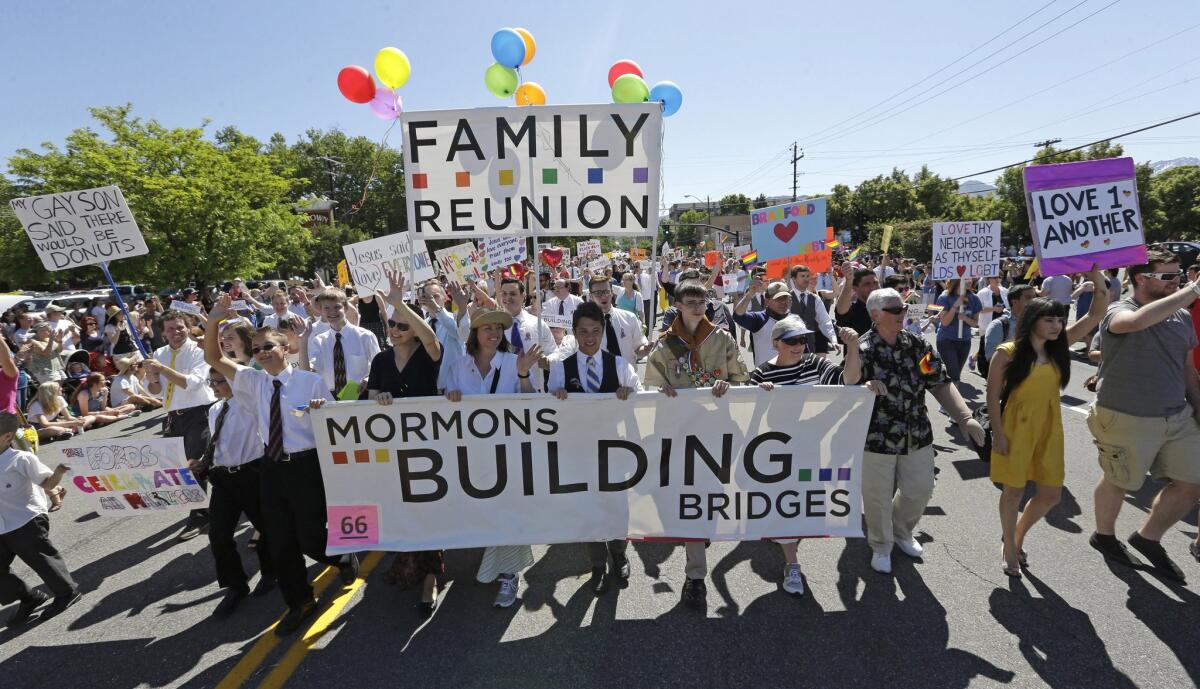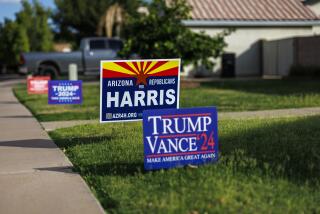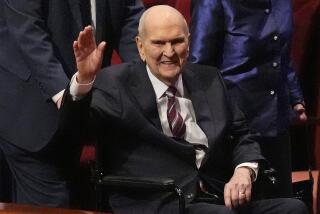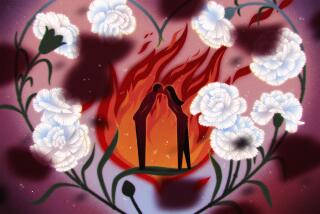An embrace that swayed the Mormon Church on gay rights

It started with a kiss.
Matthew Aune and Derek Jones were heading home from a Bon Iver concert on a summer night in 2009, strolling through Main Street Plaza just east of the Salt Lake Temple, the holiest site in the Church of Jesus Christ of Latter-day Saints.
Aune bussed his partner on the cheek. Church security guards appeared. The twentysomething men said they were cuffed and forced to the ground. The church’s official statement said the couple had been “engaged in passionate kissing, groping, profane and lewd language” on private church property, an account the two men vigorously contested.
The encounter, highlighting fissures between the powerful church and Salt Lake City, the increasingly cosmopolitan city it calls home, ultimately set the stage for Tuesday’s historic announcement by Mormon elders that the church would support protections in certain cases for gays and lesbians against discrimination in employment, housing and some public accommodation.
The 2009 incident opened the door to an unlikely series of back-channel talks between mid-level church officials and members of the gay, lesbian, transgender and bisexual community. Meeting in private homes and other venues, they spent much of the next five years exchanging views, discussing policy changes, even socializing. They shared jokes, music and sometimes tears.
“There was an opportunity to do great things,” said Brandie Balken, who participated in the talks in her former role as executive director of Equality Utah. “Or leave everything as it was.”
In the end, LGBT activists did not get everything they sought. There was never any talk of the church supporting same-sex marriage. And even when church officials agreed to support antidiscrimination ordinances, the church insisted on exemptions for religious freedom, such as laws to protect Mormon doctors who refuse to perform abortions or to assist with artificial insemination for lesbians.
Still, it was a policy change that has widely been described as groundbreaking.
The journey began three days after the public affection controversy, when protesters massed in front of the Salt Lake Temple for a Sunday “kiss-in” organized by a former city councilwoman named Deeda Seed. Shortly thereafter, church officials and LGBT leaders agreed to meet for the first time.
Within a week, 10 men and women from opposing camps were sitting down in neutral territory — the graceful Salt Lake City home of Mormon philanthropists Sam and Diane Stewart, who had previously hosted President George W. Bush, Mitt Romney and Sen. John McCain.
That first meeting “was awkward, but then we went around the room and talked about our personal journeys,” said state Sen. Jim Dabakis, a gay Democrat who describes himself as “a cultural Mormon” and has been involved in the process from the start.
“It lasted 21/2 hours. It was a remarkable meeting,” Dabakis recounted. “The representatives from the church said, ‘We want to meet again next week.’ … Without those conversations, we’d still be two camps ensconced in the mountains shaking their fists at each other.”
When the groups first agreed to meet — five LGBT activists and three mid-level officials from the Mormon Church including lobbyist Bill Evans, plus Seed and then-city Councilman Carlton Christensen — there was an immediate logistical problem.
The gay and lesbian contingent did not want to meet in church headquarters; the church officials did not want to venture into the offices of a group like Equality Utah or the Utah Pride Center. So Dabakis called Diane Stewart — friend, political activist, Mormon in good standing, same-sex marriage supporter.
Stewart calls her home in Salt Lake City’s historic Avenues neighborhood her personal “division of church and state.” The dining room of the 1930 residence overlooks the Utah Capitol. The curved glass window of the front salon frames the Salt Lake Temple.
That’s where the Stewarts held a fundraiser in 2008 for McCain’s presidential bid. It was where the first meeting of Mormon Democrats, to which Stewart now belongs, took place. And it was where Stewart welcomed the tense little group on a sweltering August day more than five years ago.
“We joked. I said, play nicely. Get along. That I love everyone in the room and that they sincerely care for one another,” Stewart recounted. “In the end, the leaders that met came to be very good friends. That was my admonition to them as they went into the meeting.”
Balken, who is lesbian, said she went into the first meeting hopeful but unsure of what to expect. Her wife was from a devout Mormon family. She had seen firsthand the pain caused when the Mormon Church had campaigned in support of Proposition 8, the 2008 California ballot measure that limited marriage to unions between a man and a woman.
“I felt like, if there was an opportunity here, it was so important for us to take it seriously and treat it thoughtfully,” she said.
The meeting was tense at first, but warmed up when the group began to speak of their lives. Balken talked about being born and raised in Utah, growing up in a small, rural community, loving to garden, wishing she had paid more attention when her grandmother taught her to preserve fruits and vegetables.
Dabakis told of his difficult youth, of a father who struggled to make ends meet, a mother who was brought low by depression, and a church — the Mormon Church — that took him in and cared for him, a church that he could no longer be part of because of his sexual orientation.
He talked about “how important the Mormon community was to him and how he lost it because of something he can’t change,” Seed recounted. “That was one of those transformative things. I know I was listening to Jim with tears in my eyes.”
To Seed, one “wonderful aspect of religion” is that it creates community. “There’s also an aspirational value of love and forgiveness and the good things that human beings aspire to. We were full of that in that room. But we could also see where the hurt was coming from.”
Church spokesman Michael Purdy, who has been involved in the conversations from the beginning, said in an email Friday that at the time the group began to meet, “there were a lot of misunderstandings between the LGBT community in Utah and the church.”
At the first meeting, Purdy said, “introductions were made, feelings were shared and questions were asked by all involved. The entire conversation, and those that followed, was defined by feelings of love and respect and a desire to make things better.”
Seed, who helped get the process started, is neither gay nor Mormon, so once the conversations were underway, she stopped going to the group’s meetings. But that November, she got a call from Dabakis or Evans — she can’t remember which — who told her to go the next City Council meeting, because “something big was going to happen.”
Salt Lake City’s elected officials had been working on a package of municipal nondiscrimination ordinances to protect gays and lesbians within city limits. There was little hope of the regulation passing, however, because of the Mormon Church’s stand on homosexuality.
A year after Proposition 8 passed in California, when the Salt Lake City Council was poised to vote on the ordinances, Michael Otterson, head of church public affairs, stood up in his official capacity and caused thousands of jaws to drop.
“The issues before you tonight are the right of people to have a roof over their heads and the right to work without being discriminated against,” Otterson told the council, meeting in packed chambers. “But, importantly, the ordinances also attempt to balance vital issues of religious freedom. In essence, the church agrees with the approach.”
That Christmas season, the LGBT activists who had come to be known as “the Gang of Five” and their same-sex partners were invited to sit in the VIP section at the Mormon Tabernacle Choir’s Christmas concert, the hottest ticket in town.
“We met in church headquarters, hugged, introduced all our partners,” recounted Dabakis, who was not a state senator when the meetings began. “As they were taking us to the VIP seats, we walked across the plaza where the kissing went on. And a church elder said laughing, ‘Anyone want to kiss? No problem.’”
Group members said meetings between the church and gay leaders were often difficult. However well-meaning the participants were, the chasm between the groups was wide.
Purdy said those who have remained in contact through the years “find much more in common than differences.” But he did acknowledge that “there are differences of opinion from time to time on specific issues.”
Balken remembers one session when the subject was second-parent adoption. According to Equality Utah, state law in Utah allows any single adult or married couple to adopt. Those couples without a legally recognized marriage license, including gay and lesbian couples, are disqualified.
For many Utah families, therefore, the law only recognizes one parent. The parent who is not recognized under the law is referred to as the second parent. Second-parent adoptions are functionally prohibited in Utah.
Balken told the group that Equality Utah was hoping to push for second-parent adoption during an upcoming legislative session. One Mormon man turned to her and said that such a law would never pass, and that she should stop pressing for it if she didn’t want to slow down the progress on antidiscrimination laws.
“I had to come out about my family,” Balken said. “My spouse is a nonbiological parent of her daughter. He said, ‘I had no idea this is happening to your family. I am sorry that it’s so difficult and challenging and personal.’”
The group began talking around 2012 about the church’s support for employment and housing protections, discussing what language might be acceptable to both sides, talking about the idea of religious liberty and the church’s desire to protect its members’ right to worship in the way they see fit.
“There were a lot of conversations about how wonderful it would be to see a faith community and the LGBT community standing together in unity, not positioned as if we were in opposite camps,” Balken said. “It was my profound hope that that will be realized.”
More to Read
Sign up for Essential California
The most important California stories and recommendations in your inbox every morning.
You may occasionally receive promotional content from the Los Angeles Times.











